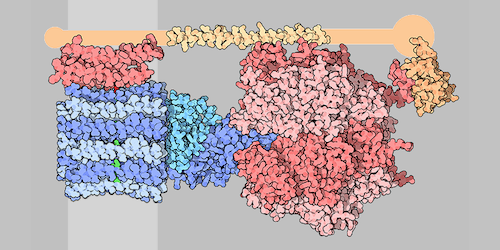The Efficiency of Tandem Molecular Machines
The energy that drives muscle contraction, nerve propagation, and other physiological processes comes from the hydrolysis of a small organic compound called adenosine triphosphate (ATP). Producing this fuel inside a cell requires a proton gradient across a membrane and the action of ATP synthase, a molecular machine. ATP synthase consists of two loosely coupled components called F1 and Fo. Single-molecule experiments have established that F1 can operate individually with near 100% efficiency. But how efficient are F1 and Fo in vivo? Matthew Leighton and David Sivak of Simon Fraser University in Canada have derived an answer by treating the coupled components and their environment as a thermodynamic system [1]. Their new result can be applied not just to ATP synthase but to any two-component molecular machines.
Leighton and Sivak’s approach entails deriving—from fundamental thermodynamic limits—upper and lower bounds on the efficiencies of components. In particular, their derivation stems from a bound on the entropy production rates of individual components called the Jensen bound, which Leighton and Sivak obtained in 2022. Such a bound is tighter than that derived from the second law of thermodynamics.
The new bounds are useful in determining the components’ efficiencies because they require knowledge of the energy exchange between the components and their environment but not of the complex details of the molecular coupling. By plugging in numbers for ATP synthase, Leighton and Sivak calculated efficiencies of 50−85% for Fo and 70−85% for F1. Given the almost perfect efficiency of isolated F1, why are the two components less efficient when coupled? Leighton and Sivak speculate that the connection could be a “floppy” one that prioritizes operating speed over efficiency.
–Charles Day
Charles Day is a Senior Editor for Physics Magazine.
References
- M. P. Leighton and D. A. Sivak, “Inferring subsystem efficiencies in bipartite molecular machines,” Phys. Rev. Lett. 130, 178401 (2023).




